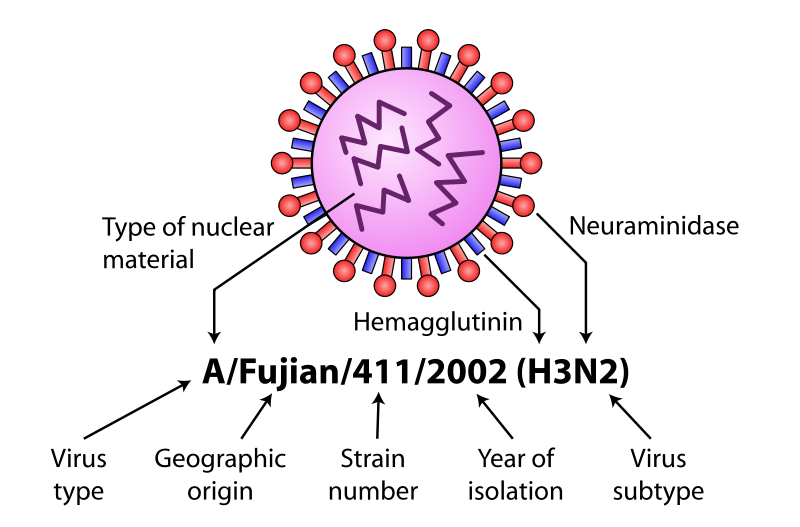Influenza viruses belong to four genera of the Orthomyxoviridae family, including Influenza A (also known as Influenza A), Influenza B (also known as Influenza B), and Influenza C (also known as Influenza A). called influenza C virus).
Influenza A viruses cause the most severe symptoms, influenza B viruses are less severe but can still cause outbreaks, and influenza C viruses usually cause mild symptoms.
Classification of Influenza Viruses
According to the different antigenic characteristics of the virus and its genetic characteristics, influenza viruses are divided into three types: A, B, and C. Influenza A virus is divided into many subtypes according to different H and N antigens. H can be divided into 16 subtypes (H1~H16), and N has 9 subtypes (N1~N9). Among them, only H1N1, H2N2, and H3N2 mainly infect humans, and the natural hosts of many other subtypes are a variety of birds and animals.
After 1997, there have been several incidents of avian influenza virus infecting people in the world. The highly pathogenic H5N1, H7N7, H9N2, and other avian influenza viruses, once mutated and capable of human-to-human transmission, will lead to human avian influenza epidemics, indicating that avian influenza viruses have a great potential threat to humans .
Influenza virus nomenclature
The current naming of influenza viruses is based on the nomenclature published by WHO in 1980, namely type/host (can be omitted for humans)/isolation location/virus strain/serial number/isolation age (HA and NA subtypes).
All known subtypes of influenza A virus can infect birds except H17N10 and H18N11, which are only found in bats.

Flu virus mutates fast
Antigenic transformation: The antigenic transformation has a large variation and belongs to qualitative transformation, that is, one or two kinds of antigenic structures on the surface of the virus strain mutate, which are different from the antigens of the previous epidemic strains and form new subtypes. immunity, thereby causing an influenza pandemic. If two different viruses infect the same cell at the same time, genetic recombination can occur to form a new subtype.
Antigenic drift: The antigenic drift has a small or continuous variation and belongs to quantitative variation, that is, intra-subtype variation. It is generally believed that this variation is caused by point mutation of the virus gene and selection of population immunity, and the epidemic caused by it is small-scale. Among the three influenza viruses that infect humans, influenza A virus has strong variability, followed by influenza B, and influenza C virus is very stable in antigenicity.
Influenza virus has high morbidity
Worldwide, about 5% to 10% of adults and 20% to 30% of children suffer from seasonal influenza each year.
Avian influenza viruses are distinguished between highly pathogenic avian influenza (HPAI) or low pathogenic avian influenza (LPAI).
Poultry infected with LPAI virus may show no signs of disease or only mild disease (such as feather wrinkling and decreased egg production). Infection of poultry with HPAI virus can cause severe disease, which can cause disease of multiple internal organs, usually within 48 hours, the mortality rate of chickens is as high as 90% to 100%.
flu pandemic
Influenza spreads around the world every year, causing about 3 million to 5 million severe illnesses and about 250,000 to 500,000 deaths.
In the northern and southern regions of the planet, outbreaks occur mainly in winter, while in regions around the equator, outbreaks can occur at any time of the year. Deaths occurred mostly among the young, the elderly and others with medical conditions.
In the 20th century, three influenza pandemics occurred: from 1918 to 1920, the world's famous severe influenza pandemic occurred in history - the Spanish H1N1 influenza. And there are multiple types of pneumonia complications, causing 20-40 million deaths worldwide. Morbidity and mortality are highest among adults aged 20-50.
1957 Asian H2N2 Influenza (2 million deaths), 1968 Hong Kong H3N2 Influenza (1 million deaths).
From November 1999 to April 2000, moderate or more influenza outbreaks occurred in Europe, America, and Asia, among which France was the most serious, with an incidence of 861/100,000 at the peak of the epidemic. However, compared with the same period in previous years, the number of cases of influenza has not increased, and the strain that caused the epidemic is still the H3N2 subtype.
How to deal with the flu virus
If you are infected with the flu, you should get enough rest, take medicines as prescribed by your doctor, and monitor the patient's condition. If your symptoms worsen, please visit your doctor in time. In addition, it is necessary to maintain a hygienic home environment, reasonable ventilation, and disinfect frequently touched surfaces. Family members who take care of the patient should also do personal protection and personal hygiene to reduce the risk of infection.
get vaccinated
Getting the flu shot is the first and most important step in preventing the flu virus. While there are many different influenza viruses, the flu vaccine protects against the most common subtypes of the virus.


